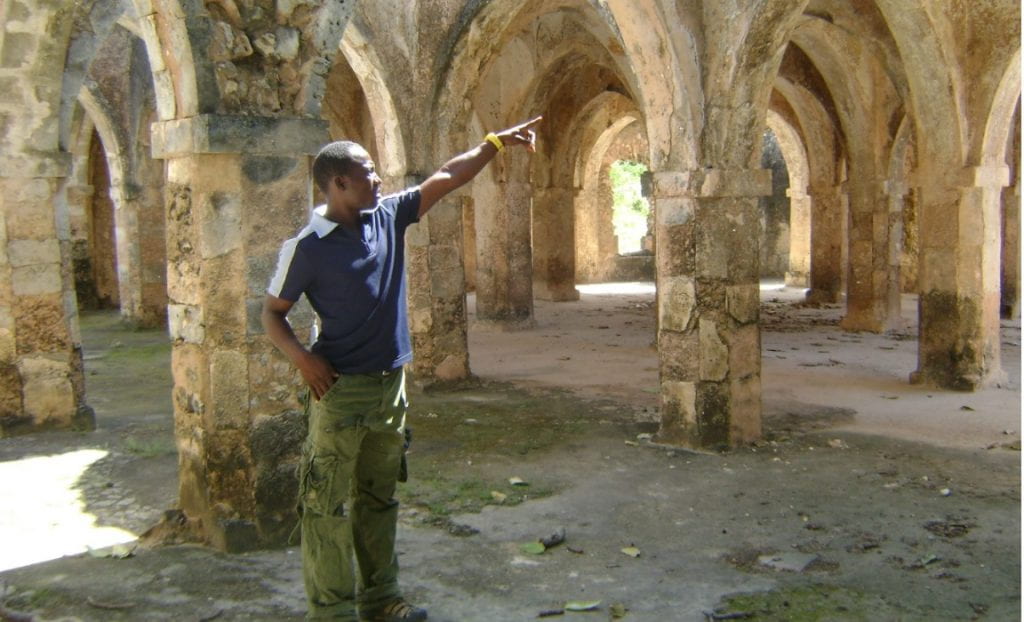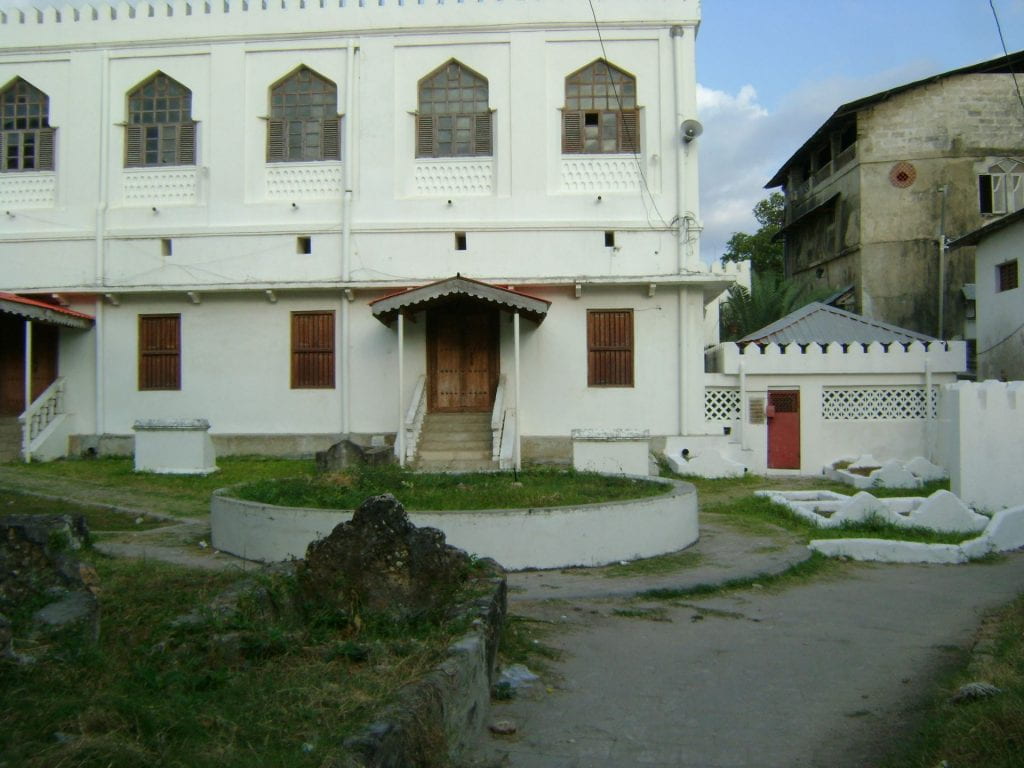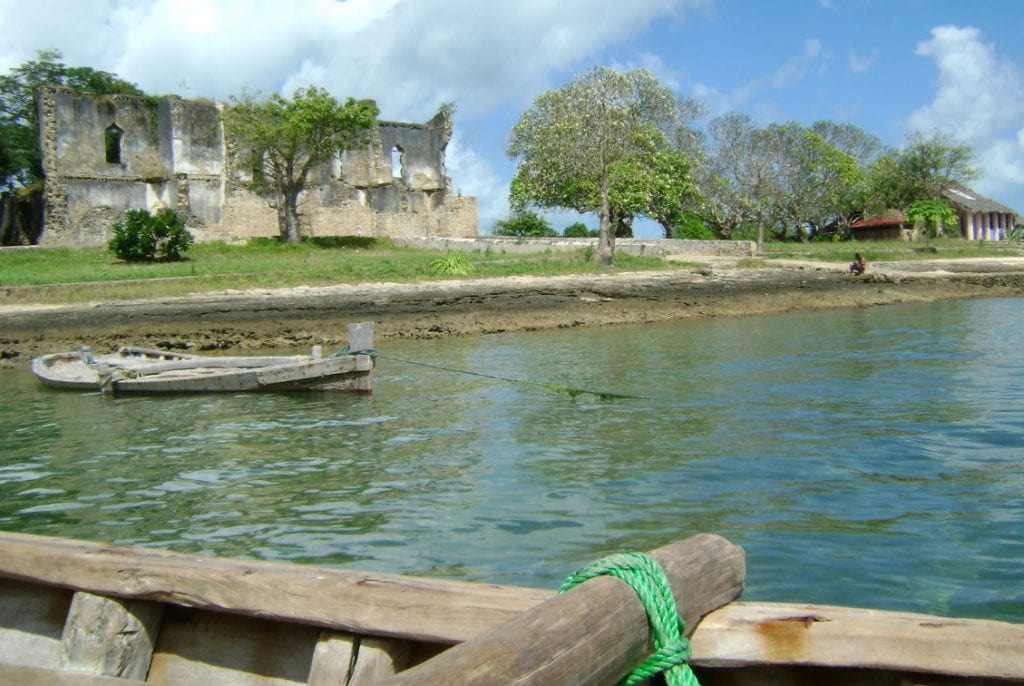Mafia, along with the other islands lying off the east coast of Africa, has shared in the long and interesting history of the area. The East Coast forms a part of the Indian Ocean littoral, and the peoples of this region have been traders and seafarers for centuries. It is an area exceptional in Africa because it is mentioned in written accounts which go back two thousand years. The earliest is a Greek text, the Periplus of the Erythraen Sea, which is dated around A.D. 110. Most subsequent accounts, up to the arrival of the Portuguese on the coast in the fifteenth century, were written by Arab geographers.
By the end of the first millenium A.D. a number of trading Islamic city-states had been established of which the earliest were on Zanzibar and Pemba Islands. By the thirteenth century, however, the chief settlement on the coast was Kilwa Kisiwani, a small island lying about 80 miles to the south of Mafia. Kilwa owed its prosperity mainly to the fact that it controlled the gold trade from Sofala (now in Mozambique).
One of the earliest documents relating to the coast is the Kilwa Chronicle, of which two versions survive, one in Arabic and the other in Portguese. In this book, Kilwa is said to have been founded by the sons of a sultan from Shiraz in Iran, who migrated in the tenth century A.D. The Kilwa Chronicle goes on to record that some of the sons of the first Kilwa sultan settled on the southwestern tip of Mafia Island, which is today called Kisimani Mafia.
The period between the twelfth and fifteenth centuries was the hey-day of the coastal civilisations of Muslim city-states: their rulers and merchants built mosques, tombs and palaces, and minted coinage; they also imported pottery and other goods from most of the known world, including China. These towns were inhabited by a mixture of Africans and traders coming from elsewhere in the Indian Ocean, particularly the Persian Gulf region.
The Portuguese arrived on the coast of Africa in 1498 and remained there for two hundred years. They took control of the Sofala gold-trade, thus causing the decline of Kilwa. However, they left little impression on the coast, beyond a few large fortresses such as those in Kilwa and Mombasa, and a handful of Portuguese words in Swahili, such as meza – table and almaria – cupboard.

The Portuguese were eventually ousted by the Omani Arabs who dominated the coast and much of the interior from the beginning of the eighteenth century until the late nineteenth century when the British and Germans colonised Kenya and Tanganyika respectively. During the Omani period, the most important settlement on the coast was Zanzibar Town, the seat of the Sultan of Zanzibar.

During this period links between the coast and interior were strengthened, based largely on the trade in ivory and slaves. This expansion of trade carried Kiswahili, by now a well-developed language with a rich written literature, into the interior of the continent.
During the period of Omani Arab rule many Arabs settled in the southern part of Mafia and set up large coconut plantations which were run by slave labour brought from the mainland.
The original inhabitants of Mafia, who called themselves Wambwera or Washirazi, were pushed into the northern half of the island, where the soil is less suitable for coconuts but more favourable for subsistence crops.
In 1890, Mafia, which had formed part of the domain of the Sultan of Zanzibar, became a part of German East Africa. Coconut cultivation was increased. The Germans themselves established large plantations and also obliged all adult males to plant at least fifty coconut trees, both in order to provide copra (widely used at the time in a variety of processes) and to have cash with which to pay taxes. They made their capital on the small island of Chole to the south-west of the main island where the ruins of their buildings are still visible today.

British troops took control of the island during the First World War, and Mafia subsequently formed part of the League of Nations Trusteeship Territory of Tanganyika which became independent in 1961. In 1964 it joined with Zanzibar to form the United Republic of Tanzania.
During the British period more European-owned coconut plantations were established in the south, and the capital of the island was moved to its present location, Kilindoni. The Arab plantations fell into decline after the freeing of the slaves in 1922.
During the period of European colonisation, Mafia shifted from being part of a coastal, island-based polity (ruled first by Kilwa then Zanzibar) and increasingly owed its allegiance to the mainland, looking both economically and politically to Dar es Salaam. Paradoxically, it also became steadily more remote and underdeveloped during this period.
The historical records of Mafia are neither numerous nor lengthy. The geographer Oscar Baumann visited the island in the late nineteenth century and wrote in a long description in German (Baumann 1986), which was translated into English and published in the journal Tanganyika Notes and Records (Freeman-Grenville 1957). A list of references is given at the end of this section.
In the 1990s, the anthropologist Christine Walley conducted research on Chole Island, and collected a good deal of oral history (Walley 2004, chapter 2; Iles and Walley nd). She divides this into three periods:
- the medieval towns of Kua and Kisimani Mafia
- the Omani Arab period of the mid to late nineteenth century when plantation slavery was widespread and Chole was the district capital of Mafia
- the European colonial period from the end of the nineteenth to the middle of the twentieth century
The oldest ruins on Mafia are located at Kisimani Mafia near to Kilindoni. Many of them have now been washed into the sea, but according to the archaeologist Neville Chittick who conducted excavations there in the 1950s, the earliest strata of mosques date from around the tenth and eleventh centuries.
Another British archaeological expedition to Kua on Juani island in the 1950s uncovered coins dating from the thirteenth to the fifteenth centuries (Freeman-Grenville 1957). Some archaeologists consider Kua was built before that, while others attribute a later date.
The most recent archaeological work on Mafia has been conducted by the Tanzanian archaeologist Felix Chami whose work has pushed much further back in time the origins of the Swahili peoples of the coast, their links with both the interior of Africa and the Indian Ocean.
References and further reading for history and archaeology
- Baumann, Oskar, 1896. Die Insel Mafia in Wissenschaftliche Veroffentlichungen des Vereins fur Erkands zu Leipzig. Verlag von Duncker und Homblot (see also Freeman-Grenville)
- Chittick, N. 1961. Kisimani Mafia: Excavations at an Islamic settlement on the East African Coast. Occasional paper no. 12. Ministry of Education, Antiquities Division.
- Freeman-Grenville, G.S.P. 1957. ‘Prefatory note to Baumann’s Mafia Island’. Tanganyika Notes and Records, 46, 1-24. (partial and not very accurate translation of Baumann’s work)
- Iles, Dudley and Christine Walley, nd. The Chole Booklet: an introduction to the island of Chole, Oxford UK.
- King, N. 1917. ‘Mafia’. Geographical Journal. 117-25.
- Piggott, D.W.I, 1941. ‘History of Mafia’, Tanganyika Notes and Records 11. (this originally appeared in the Mafia District Book)
- Revington, T.M. 1936. ‘Some notes on the Mafia Island Group’, Tanganyika Notes and Records 1. 33-7. (originally appeared in the Mafia District Book).
- Saadi, Kadhi Amur Omar, 1941. ‘Mafia – History and traditions’, Tanganyika Notes and Records 25, 23-7
- Velten, Carl, 1907. Prosa und Poesie der Suaheli. Berlin.
- Walley, Christine J. 2004. Rough Waters: Nature and development in an East African Marine Park. Princeton and Oxford: Princeton University Press
- Wheeler, Mortimer, 1955. ‘Archaeology in East Africa’, Tanganyika Notes and Records 40, 43-7.